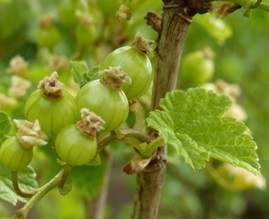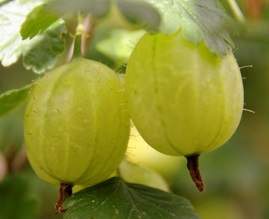How to Grow Your Own Gooseberries
Gooseberries are fantastic, easy to grow soft fruit bushes with very thorny stems, deciduous deeply lobed fresh green leaves and small, pink flushed green flowers. Bushes are self-fertile, so will reliably produce an abundance of fruit, especially for their size, without needing to be planted next to another bush in the same pollination group. There are cooking and dessert varieties of gooseberry bush but most are dual purpose, being tart or sweet depending on when they are picked: fruits picked early will be slightly sour & perfect for cooking, whilst those removed when fully mature will have a sugary and tangy flavour, perfect for eating fresh. Also known as 'goosegogs', gooseberries are ideally suited to Britain's cooler and sometimes harsh conditions. They are unfussy about soil conditions, tolerant of partial shade and even suitable for container growing, meriting a space in any kitchen garden.
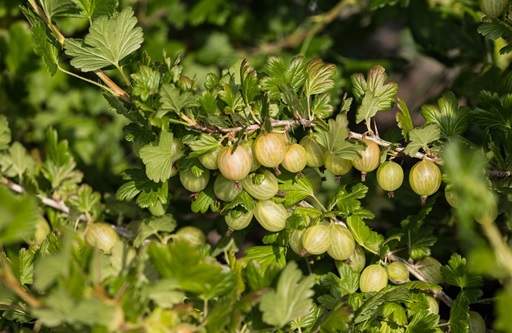
Gooseberries clothing the branches of a gooseberry bush
Fruit
Gooseberries are available in a range of colours from near-white through yellow, green and red tinged, with smooth or mildly-hairy skins, although most are green with standard big luscious fruits. They can be extremely prolific, producing 2.5kg of fruit per bush over several weeks during the summer within just 2 years of planting, so have a picking strategy at the ready! Fruits form on old wood and around the base of last year's growth and are best picked from the bottom or middle of the bush first, as these shaded berries will be the first to stop improving. Tasting better than anything you will find in the shops, gooseberries combine particularly well with elderflower to make a delicious fool dessert, and also freeze well for up to a few days.
Gooseberries really can taste like two completely different fruits depending on when they are picked - deliciously sour and firm if picked in May/June, becoming sweet and tender in June/July (Gooseberry Careless/Invicta respectively). We recommend harvesting about half of the green, under-ripe pea-sized fruit early to make sauces, tarts, jams and pies, and leaving the remainder to swell & ripen when they are best eaten fresh. This approach gives a longer cropping season and leaves more room for remaining fruit to swell and ripen once the under-ripe green berries have been removed. Fully ripe berries will have a delicious, sweet, tangy muscat-like flavour and will be packed full of natural sugar, tasting delicious. If you're unsure, gently squeeze fruits to check whether they're ripe - the ripest berries will be slightly soft.
|
Green under-ripe, pea-sized fruits |
Fully ripe, swollen gooseberries |
Recommended Gooseberry Varieties
The best gooseberry varieties are:
Gooseberry Careless - reliable, deciduous Gooseberry with thorny stems and heavy crops of large, smooth berries with a crisp flavour borne on a permanent system of fruiting side shoots in June. Whilst Careless is a cooking variety perfect for bottling and preserves if picked early, it becomes sweeter and can be used in desserts if allowed to ripen fully.
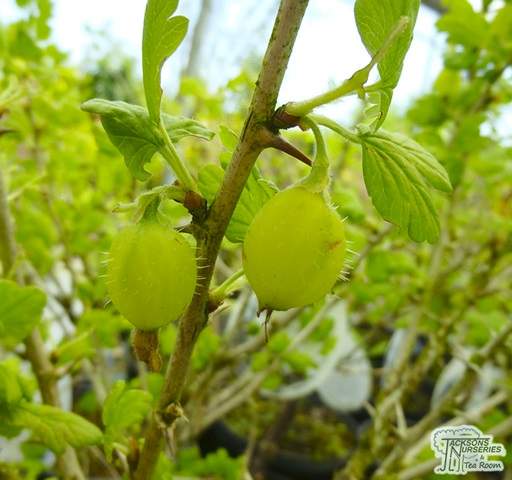
Gooseberry Invicta - robust, reliable variety with a spreading habit & very thorny stems, bearing an abundance of large yellow-green fruits read for harvesting in late May. A new variety which is disease resistant and easy to grow, Invicta can also be trained as a fan, espalier or cordon.
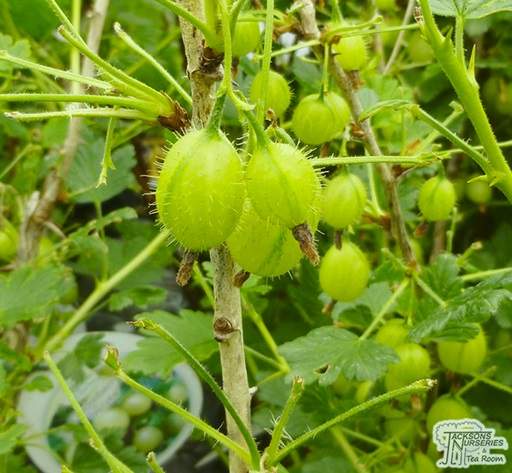
Top Tip: Grow both Gooseberry Careless and Gooseberry Invicta to extend the picking season.
Planting Advice
Container grown gooseberries can be planted at any time of the year except during long periods of dry weather or when the ground is frozen or waterlogged. October is best because this is when the soil is still warm and will give your gooseberry plants plenty of time to become established before the first cropping season (Gooseberries may even fruit in their first summer if you're lucky). Bare root gooseberries should be planted between late autumn and early spring with their roots best soaked in water for 20 minutes before planting. Goosegogs are tolerant of a wide range of soils, except those that are waterlogged, but grow best in a cool, moist but well-drained, rich clay loam. If planting in a pot or tub, choose a loam-based compost.
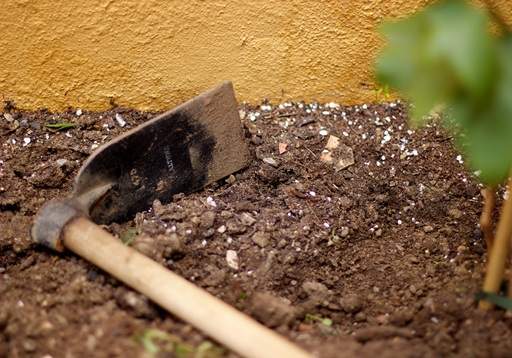
Gooseberries are tolerant of a wide range of soils, but prefer a cool, moist rich clay loam
Plant bushes 1.2-1.5m apart and cordons 30-45cm apart to allow access for picking, or train against a wall in smaller gardens to take up less space. When planting keep the surface of the rootball in line with the surrounding soil surface, mix in a handful of slow release multi-purpose fertiliser and firm the ground down well to eliminate air pockets. Mulch with a thick layer of garden compost, bark chips, well rotted manure or other organic matter to help retain moisture and prohibit weed growth around the base of your plants. If you think there will be a risk of birds stealing your crop, grow your gooseberry bushes within a fruit cage or install netting (ensuring netting is weighted down at the base to prevent blackbirds from getting underneath).
Plant Care
Watering, Weeding & Feeding
Keep well watered until established but keep water off the foliage. Bushes grown in the ground will normally only require watering when the fruits are swelling (if the soil is not already moist) and during periods of prolonged dry weather. Container-grown plants will need more regular watering on an on-going basis. Ensure the base of the plant is kept weed free to reduce competition for moisture and nutrients. Re-apply an organic mulch annually in spring to suppress weeds. Apply a couple of handfuls of bone meal in September and a slow release multi-purpose fertiliser in late winter.
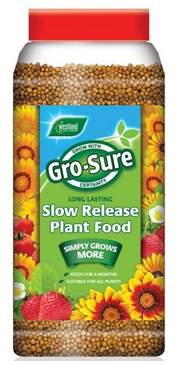
Apply a slow-release, multi-purpose plant food to your gooseberry bushes in late winter
Pruning
Good pruning and training is vital to produce a bumper crop and avoid problems with the fungus disease mildew. Aim to create an open, goblet-shaped framework by pruning the previous year's growth back to two buds and leaders back to one-third in winter using secateurs. Eliminate congested/crossing branches to make picking easier and improve air flow through the plant, and shorten side shoots to encourage fruiting. Also cut crossing, dead or diseased branches back to the main stem and eliminate low growing shoots as fruit on these will be vulnerable to pests and rodents. It's best to maintain a 10cm clear 'leg' by removing any shoots within 10cm of soil level. When pruning, cut just above an upward facing bud at 45 degrees, so the plant is encouraged to grow upwards. The advice for cordons is to prune sideshoots back to 5 leaves in summer to encourage fruiting spurs to develop and tie the leading shoot tip into the support as it grows.
Pests & Diseases
Keep an eye out for sawfly caterpillars when your gooseberries come into leaf in March. The varieties recommended above are resistant to mildew, especially if kept well watered and correctly pruned, but if it does become a problem simply spray with a fungus killer once flowering has finished.
Share this page:


